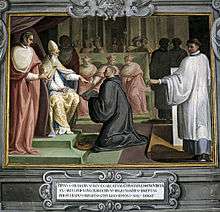Donation of Pepin

The Donation of Pepin in 756 provided a legal basis for the erection of the Papal States, which extended the temporal rule of the Popes beyond the duchy of Rome.
In 751, Aistulf, king of the Lombards, conquered what remained of the exarchate of Ravenna, the last vestige of the Roman Empire in northern Italy. In 752, Aistulf demanded the submission of Rome and a tribute of one gold solidus per capita. Pope Stephen II and a Roman envoy, John the Silentiary, tried by negotiations and bribes to convince Aistulf to back down. When this failed, Stephen sent envoys to Pepin the Short, king of the Franks, with a letter requesting his support and the provision of a Frankish escort so that Stephen could go to Pepin to confer. At the time, the Franks were on good terms with the Lombards.[1][2]
In 753, John the Silentiary returned to Rome with an imperial order (iussio) that Pope Stephen accompany him to meet Aistulf in the Lombard capital of Pavia. The pope duly requested and received a safe-conduct from the Lombards. With the Frankish envoys who had by then arrived, the pope and the imperial envoy set out for Pavia on 14 October 753. The Roman magnates did not accompany them past the border. At Pavia, Aistulf denied the requests of Stephen and John to return the conquered exarchate to the empire, but he did not prevent Stephen from continuing with the Frankish envoys to the court of Pepin. John the Silentiary did not accompany them. This was the first time a pope had crossed the Alps.[1][2]
Pope Stephen met Pepin the Short (who had been crowned at Soissons with Zachary's blessing) at Quierzy-sur-Oise in 753. The Pope was first met by Pepin's eleven-year-old son, Charles, who conveyed him to his father at Ponthion. At Quierzy the Frankish nobles finally gave their consent to a campaign in Lombardy. Roman Catholic tradition asserts that it was then and there that Pepin executed in writing a promise to convey to the Papacy certain territories that were going to be wrested from the Lombards. No original document has been preserved, but later 8th century sources quote from it and the Fragmentum Fantuzzianum probably relied on it.
On 28 July 754 Pope Stephen anointed Pepin, as well as his two sons Charles and Carloman, at Saint-Denis in a memorable ceremony that was recalled in coronation rites of French kings until the end of the ancien régime in 1792.
In return, in 756, Pepin and his Frankish army forced the last Lombard king to surrender his conquests, and Pepin officially conferred upon the pope the territories belonging to Ravenna, even cities such as Forlì with their hinterlands, laying the deeds and keys to the cities upon the tomb of Saint Peter, according to traditional later accounts. The gift included Lombard conquests in the Romagna and in the Duchy of Spoleto and Benevento, and the Pentapolis in the Marche (the "five cities" of Rimini, Pesaro, Fano, Senigallia and Ancona). The Donations made the Pope for the first time as a temporal ruler. This strip of territory extended diagonally across Italy from the Tyrrhenian to the Adriatic. Over these extensive and mountainous territories the medieval Popes were unable to exercise effective sovereignty, given the pressures of the times, and the new Papal States preserved the old Lombard heritage of many small counties and marquisates, each centered upon a fortified rocca.
Pepin confirmed his Donations in Rome in 756, and in 774 his son Charlemagne again confirmed and reasserted the Donation.
References
Sources
- Noble, Thomas F. X. The Republic of St. Peter: The Birth of the Papal State, 680–825.
- Partner, Peter. The Lands of St. Peter: The Papal State in the Middle Ages and the Early.
- Ullmann, Walter. The Growth of Papal Government in the Middle Ages: A Study in the Ideological Relation of Clerical to Lay Power.